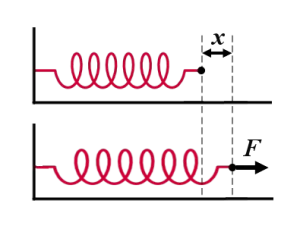This all-in-one online Hooke’s Law Calculator performs calculations using the formula of Hooke’s law which relates the force F applied to an elastic body (e.g., spring) with the size of the deformation of this body x and its stiffness k. You can enter the values of any two known parameters in the input fields of this calculator and find the missing parameter.
F = k·x
What is Hooke’s Law?
One of the physical laws that play an important role in understanding the behavior of elastic materials is Hooke’s law. Named after the famous 17th-century physicist Robert Hooke, this law gives insight into the relationship between a force applied to an object and the resulting deformation it undergoes. This empirical law was discovered in relation to springs, but under certain conditions it is applicable to many other elastic bodies.
Hooke’s law states that the force required to stretch or compress a spring is directly proportional to the displacement of the spring produced. In simpler terms, it means that the extension or compression of an elastic object is directly proportional to the force applied to it. This linear relationship between force and deformation holds true, provided the elastic limit of the material is not exceeded.

Mathematically, Hooke’s law can be expressed using the formula:
$$F = \ k \cdot x,$$
where
• \(F\) is the force applied to the free end of the spring that stretches or compresses it,
• \(x\) is the displacement of the free end of the spring from its equilibrium position,
• \(k\) is the stiffness (or spring) constant.
Note that the stiffness of a body is not so much a property of the elasticity of a certain substance, but rather a measure of the resistance to deformation of an elastic body of a certain shape made of this substance. In the International System of Units, stiffness is measured in newtons per meter (N/m).
It is important to emphasize that the above formula which we use in our Hooke’s Law Calculator contains scalar values of force and displacement, which are actually vector quantities. This means that the displacement vector is directed in the same direction as the applied force vector. That is, in the case of a negative value of the applied force (which means compression of the spring), we get a negative value of the displacement of its free end (which means reduction of the spring length).
Worth noting here that Hooke’s law is not limited to springs only. Elastic behavior can be observed in a variety of materials, including metals, rubber, plastics, and biological tissues.
Moreover, it is important to remember that Hooke’s law is valid only at small deformations. Above the limit of proportionality, the relationship between force and deformation becomes nonlinear. For many materials, Hooke’s law is inapplicable even at small deformations.
Related calculators
Check out our other physics calculators such as Moment of Inertia Calculator or Torque Calculator.